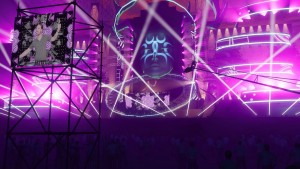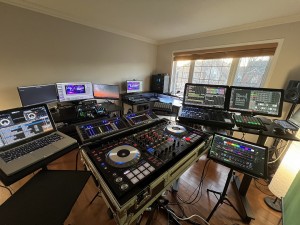Aktuelle News & Schlagzeilen
Marc-Antoine Girard reinvents DJ livestreaming with help from Obsidian Onyx platform
Marc-Antoine Girard - also known as DJ Phoenix - of Ottawa, Canada, has reinvented the DJ livestream by immersing himself in a virtual world of his own creation with a large virtual lighting setup driven by Obsidian Control Systems’ Onyx platform.
The DJ sets stream three times weekly on Twitch with Girard controlling lighting and special effects, virtual camera views and video projection content while mixing electronic dance music and interacting with viewers in a virtual nightclub environment. Stuck at home during the pandemic with no live gig to attend, Girard saw a virtual music festival online and fell in love with the concept. Seeking a challenge and a way out of pandemic lethargy, he first started livestreaming using a green screen but, finding he missed the emotion created with live lighting effects, then decided to learn virtual 3D from the bottom up.
Girard says he knew creating virtual environments was the path he wanted to take so he began to learn everything he could about it. He researched and studied, took online training courses, learned to use previz software to create his own designs, and learned Unreal Engine, a 3D computer graphics game engine. Seeking a lighting control system to run the virtual lighting, he turned to Obsidian’s Onyx platform, software he was familiar with from his experience with the M1 lighting console from his early years as a lighting tech/designer.
Today, Girard runs Studio Phoenix Media and boasts a modern production studio equipped with Obsidian’s NX Wing and NX Touch - plug-and-play control surfaces to the Onyx platform - along with video mixing controllers, media servers, lighting design previz, 3D game engine, and video editing software, all of which he uses to create a virtual show experience. He implements it all in his live DJ streams where he plays music while busking lighting, controlling virtual cameras and VJing. He also includes a behind-the-scenes camera so that viewers can watch as he orchestrates it all.
“I’ve always been a huge fan of electronic music festivals, where the various lighting operators have to use their creativity and busking skills to dynamically match the lights for the live act without knowing what the next song will be”, Girard states. “Since my own DJ playlist is never predefined, it was important for me to be able to improvise with the lights really quickly while staying creative, depending on the song that I’m playing. This is why I’ve chosen to build my showfile with many playback windows, grouping multiple macros and cues with specific functions for every different type of fixture.”
To control the virtual lighting setup with Onyx, the designer works with two touchscreens, two NX Touch control surfaces and one NX Wing. Girard explains his process: “On the first monitor, I have one playback window with independent color cues for all the fixtures, one window for the pan & tilt looks, animations and FX timing, one playback window for the gobos, color FX & timing, and a window for my macros and special cues. The second monitor has a submaster panel, a BPM beat editor and a Dylos parameter with zone output.”
“My first NX Touch is set to control the effects for the various fixtures in which most of the playbacks are set as overrides to control the dimmer speed FX, the pan & tilt swing FX (width of the animation), the pan & tilt FX speed, the colors FX speed, gobo rotation speed, the beam size and the iris”, he continues. “The second NX Touch is set to control the lighting intensity and FX cues for the ‘secondary’ effects lighting such as the 6x3 LED bar, the strobe lights, the LED Pars, the Mentis lights, the DJ FOH and the ambient lights. I’m using the playback buttons on the two NX Touch to punch special dynamic effects for the pyrotechnic (cold sparks), strobe hits (pulse, delay, open), blinders, white overlays, and gobo/beam effects on the various fixtures that I’m using.”
“The main console NX Wing is set to control the intensity and the dimmer FX on the moving spots and the moving wash fixture groups”, he says. “I like to be able to throw an effect on all the spot fixtures but choosing independently on which groups the effect is going to be applied. This way I can control and manage the infamous ‘flash & trash’ that is often criticized on EDM festivals and keep the magic by alternating the effects on the various groups over the nights. While some are moving and flashing, the others are set as static looks to support the effects and vice versa.”
“Finally, I also have a third touchscreen monitor with two Akai APC mini hooked with Resolume Arena to control the VJ clips that are projected on the virtual LED screens”, Girard concludes. “The 25 sequenced Unreal Engine virtual cameras around the nightclub are independently controlled with a 32-key Elgato Stream Deck XL. All of these, combined with DJ’ing and interacting with the viewers, make the multi-tasking pretty intense but so much fun! It’s like playing a video game.”
Girard acquires his Obsidian products the same place he purchased his M1 console years ago, through his father’s company Perfecson of Ottawa.
(Photos: Marc-Antoine Girard/Obsidian Control Systems)
SCHLAGZEILEN
news archiv
suche
© 1999 - 2025 Entertainment Technology Press Limited News Stories












